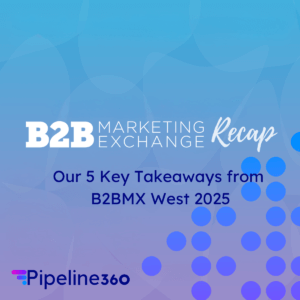The right data leads to predictable pipeline and helps transform clicks into potential customers ready to be nurtured to conversion.
When it’s done right, it’s simple and it works. Data is key, and it unlocks new business.
But that’s not the experience for everyone, with dodgy data de-railing processes, poisoning pipelines, wasting resources, and turning marketing and sales teams against each other.
Bad data just doesn’t convert.
Poor data sources, fraudulent providers and leads that don’t lead anywhere, have made data a thorn in the side for teams, and been a black cloud over the industry, for years. For many B2B marketers, the devil really is in the data, and it makes showing ROI a hell of a battle.
Pipeline360’s “The State of B2B Pipeline Growth” revealed the extent of the data dilemma with 46% of respondents expressing dissatisfaction with the quality of their current leads and 42% citing insufficient lead quantity.
Yet, for 80%, getting qualified leads was critical and urgent.
Global and state privacy laws have added another layer of complication to the data process, with penalties reaching eight-figures for non-compliance, meaning getting data wrong now has the potential to cripple, and even close, businesses.
That’s probably why 93% of B2B marketers we surveyed said that data compliance and accuracy is a priority at their company.
B2B marketing has become an obstacle course and a balancing act: teams need to generate high-quality leads by avoiding all the potholes that exist with lead-generation, and then balance potential clients’ penchant for personalisation, while existing in a rapidly changing and regulated environment.
Traditional lead generation tactics just won’t cut it. It’s time for a new approach. One that works, and one that will safeguard you from compliance complications.
Here’s how B2B marketers can overcome these challenges and drive pipeline growth.
Compliance – it isn’t a choice
Don’t play Russian roulette with data, get it right from the get-go, so you can go about your nurture with the peace of mind that comes with operating inside global and state privacy laws. This includes obtaining proper consent from individuals, maintaining accurate records, and having processes in place for data protection and deletion upon request.
Data is a real ‘get what you pay for’ product, and if you fill your pipeline with rubbish, that’s exactly what you’ll have flowing through your funnel all the way to the CFO, and no one will thank you. Inaccurate or outdated data wastes time and resources, compromises closeable prospects, and it might even lead to fines. The one place good data will never lead you.
By investing in a data governance platform or partnering with a trusted provider, B2B marketers are guaranteed accurate, up-to-date data that’s compliant with regulations.
Transparency builds trust and fosters loyalty
Privacy laws might seem like a minefield for B2B marketers, but compliance is also a tool they can use to build trust with customers who share those concerns.
Transparency around data collection and usage, along with providing options for individuals to control theirs, makes everyone feel safer, more connected. Trust, transparency and reliably breed loyalty.
When customers trust your brand and the data you collect, they’re more likely to invest in the process, get onboard the nurture, engage with the campaign, provide feedback and become advocates for your company long after they’ve signed on.
Data hygiene smooths the way to business success. So, the next time you’re working on a marketing campaign or collecting customer data, remember data privacy isn’t just a legal obligation you need to get right, it’s also a tactic, if front-footed correctly, to help build relationships and foster loyalty with your audience.
It’s time to change the channel and try new things – Don’t limit your success
The days of relying on email marketing and trade shows to collect customer data are done, the market has fractured and evolved and while these tactics still work, B2B marketers need to broaden their approach to reach a wider audience and maximise their chances of reeling in new business.
It’s a new era for lead generation and B2B marketers need to broaden their approach well-beyond traditional tactics.
B2B buyers are largely doing it all themselves now, on platforms marketers don’t control. They’ve found the self-checkout and checked out from the linear journey we’ve laid out for them, consuming content across multiple-channels as they choose, on their own timeline, not ours.
Limiting tactics and channels of engagement isn’t an option. Marketers can’t simply drop a line or two, and wait for bites, they must target buyers everywhere, all the time, with relevant and valuable assets personalised and optimised for each stage of the buying journey.
Incorporating other channels like social, digital display ads, and content syndication throws open the doors to the widest possible audience so teams can capture more, and better leads. It also builds trust and credibility, and helps establish your brand as a thought leader. And that way, when it’s time for Sales to call, buyers are already up-to-speed on your brand, more likely to engage, and more likely to convert.
The State of B2B Pipeline Growth survey found that 61% of B2B Marketers who use content syndication (CS) as part of a full-funnel, brand + demand strategy are able to reach pipeline goals versus 45% for those who don’t use CS.
The integration of targeted display and CS is Branded Demand and creates a cohesive and effective demand generation strategy that drives results. Using these tactics separately isn’t enough. They both work, but they work much better together. To capitalise on Branded Demand, B2B marketers must merge the tactics into the overall strategy. The integration can maximise reach, engagement and improve conversion rates.
However, as you expand your channels for data collection, it’s crucial to maintain transparency, securely store it, be clear about how and why you’re collecting it from customers and ensure that their personal information is protected.
Embrace change and demand more
The demand for better leads will only intensify as businesses strive to stay competitive and grow in an increasingly complex, hostile, and digital marketplace. But by embracing data privacy and compliance and diversifying lead-gen strategies, B2B marketers can meet the challenge head-on. Generate more, and better leads and drive new business.
By caring about leads, reputations and regulations, B2B marketers are laying the foundations for long-term relationships. And by trying new things, in new places, they’re guaranteeing better outcomes.
It’s time for our industry to demand more from their Demand Generation and get the results they deserve.






